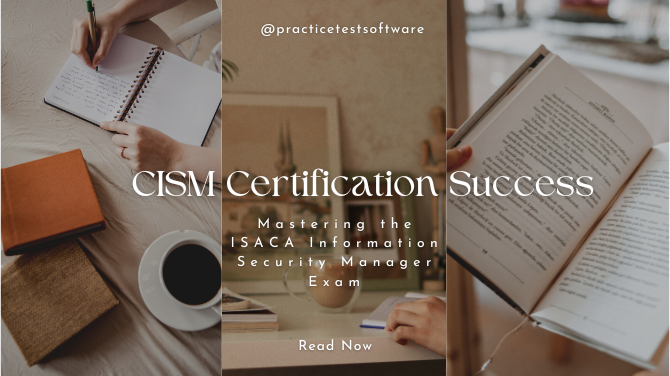In today’s digital-first business world, organizations face increasing threats to their information systems. To tackle these challenges, companies need leaders who can manage security programs and align them with business objectives. This is where the Certified Information Security Manager (CISM) certification from ISACA comes into play.
If you’re aiming for senior roles in information security management, governance, or risk, the CISM certification is a game-changer. In this guide, we’ll cover what the certification is, who should pursue it, the exam structure, and proven strategies to succeed in passing the ISACA Information Security Manager exam.
What Is the CISM Certification?
The CISM certification is a globally recognized credential designed for professionals responsible for managing, designing, and overseeing enterprise-level information security programs. Unlike technical certifications, CISM focuses on management and strategy, bridging the gap between information security and business needs.
It proves that you not only understand IT security principles but can also lead teams, manage risks, and ensure that security practices support business goals.
Who Should Take the CISM Exam?
The CISM certification is ideal for mid- to senior-level professionals, including:
- Information Security Managers
- IT Governance Professionals
- Security Consultants and Advisors
- Risk Management Professionals
- Compliance Officers
- Aspiring leaders in cybersecurity and IT governance
If you want to transition from a technical IT security role into a strategic leadership position, CISM is the perfect next step.
CISM Exam Structure 2025
Before you dive into preparation, it’s important to understand the exam format:
- Duration: 4 hours
- Number of Questions: 150 multiple-choice questions
- Passing Score: 450 out of 800 (scaled)
- Exam Domains:
- Information Security Governance – Establishing and aligning security strategy with business goals.
- Information Security Risk Management – Identifying, analyzing, and mitigating security risks.
- Information Security Program Development and Management – Designing and maintaining enterprise-wide security programs.
- Information Security Incident Management – Developing and managing incident response processes.
Proven Strategies to Pass the CISM Exam in 2025
Preparing for the CISM certification exam requires a mix of strategic study, practice, and business-focused thinking. Here are proven strategies to help you succeed:
1. Use the Official ISACA CISM Review Manual
Start your journey with the CISM Review Manual published by ISACA. It’s the most reliable guide as it aligns directly with the exam domains. Highlight key terms and read it thoroughly at least twice.
2. Build a Structured Study Plan
Set aside 3–4 months of preparation time. Break down your study by domain and create weekly goals. For example:
- Weeks 1–2: Domain 1 (Governance)
- Weeks 3–4: Domain 2 (Risk Management)
- Weeks 5–6: Domain 3 (Program Management)
- Weeks 7–8: Domain 4 (Incident Management)
- Weeks 9–12: Practice exams, review, and revision
3. Practice with CISM QAE Database
ISACA’s Questions, Answers & Explanations (QAE) Database is one of the best resources for practice. It familiarizes you with the question style and helps you build exam confidence.
4. Think Like a Manager, Not a Technician
A common mistake is approaching the exam from a technical mindset. CISM is about management and decision-making. When answering questions, always think about what a security manager would prioritize — risk, governance, or business alignment.
5. Join Study Groups and Forums
Collaboration helps. Join ISACA chapters, LinkedIn groups, or online forums where candidates share study strategies and tips. Engaging with others can give you new perspectives and keep you motivated.
6. Revise Real-World Scenarios
CISM exam questions often present business cases. Practice analyzing real-world scenarios where you need to choose the “best” solution rather than the most technical one. This will sharpen your problem-solving skills.
7. Manage Your Exam Time
You’ll need to answer 150 questions in 240 minutes, which gives you less than 2 minutes per question. During practice exams, train yourself to manage time. Mark difficult questions and return to them later instead of wasting valuable minutes.
8. Stay Consistent and Avoid Burnout
Consistency beats cramming. Study a little each day rather than long hours once in a while. Also, take short breaks to avoid information overload.
Exam-Day Tips
- Arrive early at the exam center (or log in early if testing online).
- Read each question carefully and eliminate obviously wrong answers.
- Stay calm and avoid second-guessing yourself too much.
- Keep track of time and pace yourself evenly across all domains.
Career Benefits of CISM Certification
Achieving the CISM certification brings multiple career advantages:
- Global Recognition: CISM is respected worldwide and is often a requirement for senior security leadership roles.
- High Salary Potential: CISM-certified professionals are among the top earners in IT security.
- Leadership Opportunities: It opens doors to managerial and executive-level positions.
- Professional Credibility: Establishes you as a trusted leader who can align IT security with business goals.
The CISM certification is more than just a credential it’s a stepping stone to leadership in information security management. By using the official ISACA resources, practicing consistently, and approaching the exam with a managerial mindset, you can confidently pass the exam in 2025.
With strong preparation and focus, you’ll not only succeed in the exam but also elevate your career to new heights in cybersecurity leadership.

